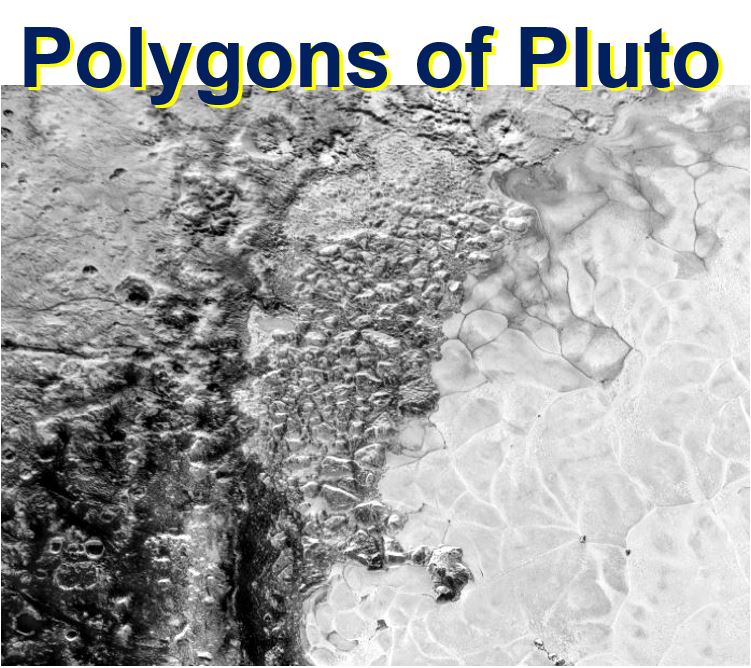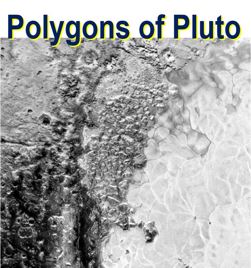At yesterday’s New Horizon’s blog, Katie Knight, an undergraduate student at Carson-Newman University in Jefferson City, Tennessee, USA, wrote about the Polygons of Pluto.
Ms. Knight works with the New Horizon’s team to help map some of the unusual terrain on the dwarf planet, seeking patterns and estimating how big and what shape some of its unusual features have.
“I’m here to talk about Pluto’s unusual geological features known as polygonal blocks. If you look to the upper left of Pluto’s ‘heart’ – informally-named Sputnik Planum – you will see some chaotic terrain that is very different than the almost smooth terrain of the icy plains.”
“These are the Al-Idrisi Montes, and they are filled with blocks measuring miles to tens of miles across.”
 Close up of Pluto’s Al-Idrisi Monte. An example of chaotic polygon-shaped terrain as captured by NASA’s New Horizons spacecraft on July 14, 2015. (Image: NASA/JHUAPL/SwRI)
Close up of Pluto’s Al-Idrisi Monte. An example of chaotic polygon-shaped terrain as captured by NASA’s New Horizons spacecraft on July 14, 2015. (Image: NASA/JHUAPL/SwRI)
Blocks vary considerably
Within every small region, the blocks can be quite different. Some are really distinct and seem taller – without any other blocks touching them – while others become slightly more complicated. Ms. Knight’s job is to try to separate out which is which.
For example, she analyzes them to try to see whether these blocks might actually be one large block with some variation in height, or whether they are completely separate ones.
The high-resolution images New Horizons captured detail the surface with remarkable clarity, but they can only show so much.
To look at the size and shape of the blocks, Ms. Knight traces them. The aim is to trace around the base of the blocks, including all the visible sides. Some of the blocks cast shadows which makes it extremely hard to see the sides.
 Sputnik Planum is the bright, western half of the heart shaped area near the middle of this enhanced Pluto image. The Al-Idrisi mountains are next to Sputnik’s northwestern edge. (Image: NASA/JHUAPL/SwRI)
Sputnik Planum is the bright, western half of the heart shaped area near the middle of this enhanced Pluto image. The Al-Idrisi mountains are next to Sputnik’s northwestern edge. (Image: NASA/JHUAPL/SwRI)
Ms. Knight added:
“I am looking to see if there is an area range that is most common or potentially if there is a common shape. It can get complicated, since some blocks seem to blend together. The shadows that the sun casts on the blocks further complicates this analysis, but a lot can be distinguished. The blocks significantly vary in size and shape, but there may be some similarities between them that can be determined.”
After this first look at shape and size, there are several other things scientists can also analyze. Topography can tell us how high the blocks are, and how similar their areas and heights are.
Both grey-scale and colour images analyzed
Ms. Knight is using grey-scale images from New Horizons to analyze the basics. She will later analyze the colour images too – colour can tell use more about the surface.
If we can learn the basics of these blocks, our knowledge of how ice blocks are formed will improve. There are several theories, and studying blocks on others planets will tell us even more.
Today’s blog is about polygonal blocks on #Pluto, thx to Katie Knight of @cneagles. https://t.co/88W2RBRuiR pic.twitter.com/YQhd05YxTc
— NASA New Horizons (@NASANewHorizons) 7 March 2016
Chaos terrains, like these on the Pluto images, while very different, can be compared to chaos on Europa and Mars to see what is common between all three of these celestial objects.
Ms. Knight added:
“The area I am looking at may be relatively small, but there is a lot we can learn from these blocks and I can’t wait to see more of what Pluto has to offer!”
Video – NASA lost contact with New Horizons on Pluto
As New Horizons was about to fly by Pluto, the probe’s computer suddently went offline and NASA on Earth lost contact.

